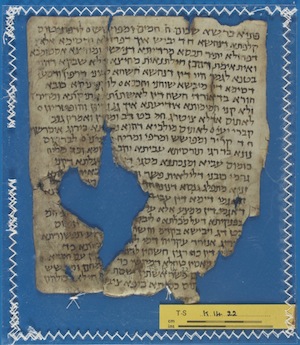The first discovery of Judaeo-Syriac: T-S K14.22
By Siam Bhayro (with the assistance of Ben Outhwaite)
The presence in the Cairo Genizah of manuscripts written in Syriac has been known since the earliest days of Genizah research, with the sisters Agnes Lewis and Margaret Gibson publishing some of the first discoveries in their book, ‘Palestinian Syriac texts from palimpsest fragments in the Taylor-Schechter Collection’ (Cambridge 1900). As the title indicated, Syriac had found its way into the synagogue storeroom as the undertext of palimpsests, the parchment having been reused to write piyyuṭim, the Palestinian Talmud and other rabbinic works.
T-S K14.22, a small parchment leaf, is not among their Syriac fragments, and righty so, since it is not in the Syriac script. The great scholar of Genizah medicine Haskell Isaacs originally catalogued it in his ‘Medical and Para-Medical Manuscripts in the Cambridge Genizah Collections’, describing it as materia medica in Aramaic – a list of medicinal substances. And so it is. But when I examined the text, I read this phrase with great interest:

ואף השא או חביבן כתבינן סדרא דתלת עשר דאיתיו מים אתותא
‘And also now, O our beloved, we write the thirteenth chapter, which is the letter mem.’
What immediately struck me as odd was the word או, which is a vocative particle, but one alien to Jewish Aramaic, being found only in Syriac. On looking further, I discovered a number of other linguistic features that show that a Jewish scribe had transcribed a Syriac medical text (a descriptive list of materia medica, organised alphabetically) into Jewish Aramaic characters, thus giving us the only fragment of Judaeo-Syriac so far discovered, a unique and important discovery in the Genizah.
The origins of the fragment are probably to be found in Syria or northern Palestine, as suggested by the handwriting and, most interestingly, the presence of Palestinian vowel signs.

The occasional vowel signs used in the text can only be understood as those of the Palestinian vocalisation system (here, the signs for u and a).
The existence of this fragment shows that, despite the availability of Arabic medical texts, a Syriac work was still deemed important enough to put into a Judaeo-Syriac ‘translation’, and it testifies both to the ongoing importance of Syriac as a language for the transmission of ancient knowledge and to the ease with which scientific knowledge transcended the barriers of language and religion.
For the full publication of this fragment, see my article ‘A Judaeo-Syriac Medical Fragment from the Cairo Genizah’, Aramaic Studies 10.2 (2013), pp. 153–172.
Recto of the unknown medical text in Judaeo-Syriac.
Bibliography
Isaacs, H. D., Medical and para-medical manuscripts in the Cambridge Genizah collections (Cambridge, 1994).
Lewis, Agnes Smith and Gibson, Margaret Dunlop, Palestinian Syriac texts from palimpsest fragments in the Taylor-Schechter Collection (London, 1900).
Cite this article
Bhayro, S., & Outhwaite, B. (2013). The first discovery of Judaeo-Syriac: T-S K14.22. [Webpages]. https://doi.org/10.17863/CAM.62330
Contact us: genizah@lib.cam.ac.uk
The zoomable images are produced using Cloud Zoom, a jQueryimage zoom plugin:
Cloud Zoom, Copyright (c) 2010, R Cecco, www.professorcloud.com
Licensed under the MIT License

